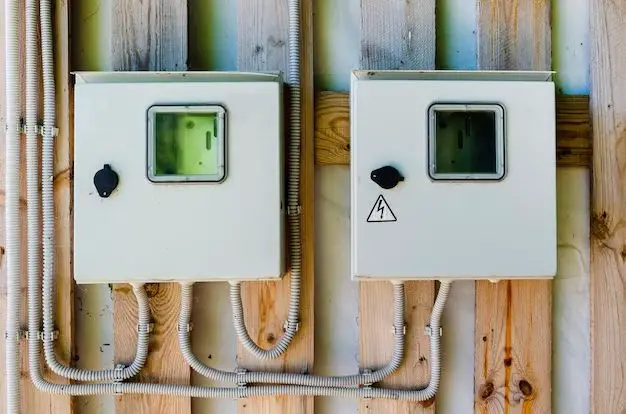When installing outdoor electrical outlets, lights, or other fixtures, choosing the right type of electrical box is crucial. The outdoor electrical box protects the connections from weather and environmental hazards. Selecting an electrical box designed for exterior use ensures safe and reliable outdoor power.
Page Contents
- 1 Weatherproof vs. Watertight Electrical Boxes
- 2 Common Types of Outdoor Electrical Boxes
- 3 Metal vs. Plastic Boxes
- 4 Sizing the Electrical Box
- 5 Outdoor Electrical Box Installation Tips
- 6 Grounding the Outdoor Electrical Box
- 7 GFCI Protection for Outdoor Outlets
- 8 Choosing a Cover for the Electrical Box
- 9 Conclusion
Weatherproof vs. Watertight Electrical Boxes
There are two main categories of electrical boxes for outdoor use:
- Weatherproof – Designed to prevent rain, snow, and dust from entering the box. Allows some moisture to enter but prevents water immersion.
- Watertight – Completely sealed to prevent any water from entering the electrical box, even when immersed in water.
Watertight boxes provide the highest level of protection for wet areas like irrigation valve boxes. Weatherproof boxes work for most general outdoor outlets and fixtures.
Common Types of Outdoor Electrical Boxes
Within the weatherproof and watertight categories, there are several specific box types suitable for outdoor installation:
While In Use Covers
These weatherproof boxes have a cover that can close over the plug or cable while it is still connected. The gasketted cover seals out moisture while allowing the outlet to be used. Choose in-use covers for any outdoor receptacles.
Extention Rings
Extention ring boxes allow the base electrical box to be extended toward the surface of the wall or post. This positions the outlet further from the mounting surface for easier access. Use extention ring boxes when outlets need to be mounted on thick or irregular surfaces.
Post Lights
Post light boxes allow wiring connections for outdoor light fixtures mounted on hollow posts or poles. Choose post light boxes for path lights, post-top lamp posts, and other post-mounted outdoor lights.
Round Boxes
Round weatherproof electrical boxes suit round outdoor fixtures like pendant lights, spotlights, and flood lights. Use round boxes to match the shape of the light housing.
Gangable Boxes
Gangable electrical boxes allow multiple devices to be wired through one exterior junction box. Choose gangable boxes when installing multiple outdoor outlets, switches, or lights together.
Masonry Boxes
Masonry boxes can be embedded directly into poured concrete, brick walls, and other solid masonry materials. Use masonry boxes for a flush professional finish.
Metal vs. Plastic Boxes
Outdoor electrical boxes also come in different materials:
- Metal – Cast iron, aluminum, and galvanized steel boxes are rugged and provide good grounding. Metal offers the best durability.
- Plastic – Non-conductive plastic boxes will not corrode. However, plastic is more prone to sun damage and cracking over time.
For most outdoor outlets, lights, and wiring, choose a sturdy weatherproof metal electrical box for maximum protection and longevity.
Sizing the Electrical Box
Choosing the correct size outdoor electrical box is also important:
- The box must be large enough to accommodate the number of wires and connections inside.
- The box must be deep enough to allow for connectors and a minimum of 6 inches of spare wire length.
- Larger boxes provide more workspace and are easier to wire.
Refer to electrical codes for the minimum recommended box size for different wiring and load requirements. Allow extra space for any future expansion.
Outdoor Electrical Box Installation Tips
To safely install outdoor electrical boxes:
- Choose box locations sheltered from direct weather exposure when possible.
- Mount the box vertically to allow moisture to drain out.
- Caulk around the exterior box edges for extra sealing from water.
- Use outdoor-rated conduit and connections suitable for wet locations.
- Provide drip loops in the wires entering the electrical box bottom.
- Close all unused box openings with plugs or silicone sealant.
Grounding the Outdoor Electrical Box
Always ground the outdoor electrical box by connecting it to the earth and bonding it to the system ground:
- Connect a ground wire from the box to a grounding rod buried below the frost line.
- Bond the box to other grounded metal parts of the electrical system.
- Use listed grounding clamps and copper wire meeting code requirements.
Proper grounding paths allow fault currents an escape route to prevent electric shock hazards.
GFCI Protection for Outdoor Outlets
Outdoor receptacles must be protected by a ground fault circuit interrupter (GFCI) for safety. GFCIs shut off power quickly if an electrical fault is detected to prevent serious shocks.
Choose one of these options for GFCI protection:
- Install a GFCI outlet in the outdoor electrical box.
- Use a regular outlet protected upstream by a GFCI circuit breaker.
- Connect the outdoor outlet downstream of a GFCI outlet located indoors.
Test outdoor GFCIs monthly by pressing the “Test” button to confirm protection is working.
Choosing a Cover for the Electrical Box
The weatherproof cover should seal tightly over the box opening to keep moisture out. Common options include:
- Concentric Knockouts – Allow cable entry through the back or sides while maintaining a tight seal.
- Gasketed Covers – Use rubber gaskets to seal the cover edges to the box.
- Foam Covers – Have a foam liner to prevent air and water infiltration.
- Bubble Covers – Provide a flexible cover that fits over plugs and cords.
Choose the most appropriate cover style for the electrical box type and intended use.
Conclusion
Choosing the right outdoor electrical box ensures safety and performance. Watertight metal boxes provide the best protection for wet areas. While in use covers allow outdoor receptacles to be used in the rain. Size the box properly, ground it correctly, and add GFCI protection. With the right outdoor box installed by a professional, you can have durable and code-compliant exterior power for lighting, outlets, and equipment.
